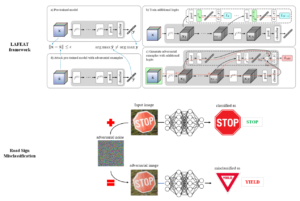The University of Macau (UM) and the Shenzhen Institute of Advanced Technology of the Chinese Academy of Sciences (SIAT) jointly proposed a new loss function that can use model features and New loss function to improve the LAFEAT method of model robustness evaluation, which achieves the best result in all model robustness evaluations in recent years. Papers were published in the international top conference in the field of artificial intelligence, with a selection rate of only 4.59%. By using this algorithm, UM-SIAT team has participated into an international algorithm competition recently, namely “CVPR Security AI Challenger” organized by the University of Illinois, Tsinghua University and Ali Security. The UM-SIAT team competed with total 1,681 teams around the world and won the 2nd prize, marking UM as the only winning team of Macau.
Driven by artificial intelligence technology and deep learning, autonomous driving technology has achieved rapid development in recent years. Deep learning has been integrated into the field of perception, decision-making and the control of autonomous driving. However, the current deep learning models are facing severe robustness issues, the visual perception system of autonomous driving is vulnerable to malicious attacks from adversarial samples, adding image data, and subtle disturbances that are difficult for humans to recognize through the senses, etc., which can make the model make wrong judgments. Therefore, establishing an effective model robustness evaluation mechanism is an indispensable cornerstone for building a truly safe and feasible autonomous driving system. In response to this issue, UM and SIAT proposed a new loss function that efficiently utilizes model features and solves the effects of floating-point calculation errors by adding new branches to improve model robustness evaluation method LAFEAT, and achieves it in all model robustness evaluations. The result has been published in Computer Vision and Pattern Recognition (CVPR), a top conference in the field of artificial intelligence. The first author of this paper is Yu Yunrui, a student of Prof. Xu Cheng-Zhong who is the Dean of Faculty of Science and Technology and the academic leader of the State Key Laboratory of Smart City Internet of Things. Another first author Gao Xitong is the assistant researcher of SIAT under the guidance of Prof. Xu Cheng-Zhong.
The research project, titled ‘Research on Key Technologies and Platforms for Collaborative Intelligence-Driven Autonomous -Driving Vehicles’ is a key research and development project funded by the Macau Science and Technology Fund (FDCT) (file number: 0015/2019/AKP). It is one of the largest research projects in Macao’s history and it shows the power and reputation of UM’s scientific research. The Faculty of Science and Technology aims to establish a world-class scientific research and talent training base. In response to the rapid changes in the world, especially the world’s demand for the digital economy. The State Key Laboratory of Smart City Internet of Things is the first national key laboratory in the field of Smart City Internet of Things approved by the Ministry of Science and Technology, focus on solving the key scientific and technical issues of the Internet of Things in smart cities.
澳大和中科院深圳先進技術研究院聯合提出了一種通過添加新的分支高效利用模型特徵和解決浮點數計算誤差影響的新型損失函數,提升模型魯棒性評估的方法LAFEAT,並在所有的模型魯棒性評測中達到目前最好的效果。論文以最高級別形式在人工智能領域公認的頂尖會議 -國際計算機視覺與模式識別會議上發表,該會議的論文錄取率僅為4.59%。憑借此算法為核心,聯合團隊研發了一款攻防軟件並參加了由美國伊利諾大學、清華大學和阿里安全聯合組織「CVPR安全AI挑戰者賽」,與全球共1,681個團隊相互切磋,最終獲第二名的佳績,是全澳唯一獲獎的高校。
以深度學習為首的人工智能技術的推動下,自動駕駛技術近年取得突飛猛進的發展,深度學習技術已經深入融入到自動駕駛的感知層,決策層與控制層等眾多領域。但同時當前深度學習模型面臨著嚴峻的魯棒性問題的挑戰,例如自動駕駛的視覺感知系統容易受到對抗樣本的惡意攻擊、對圖像數據添加、人類難以通過感官辨識到的細微擾動等,皆可令模型做出錯誤的判別。錯誤感知對運行中自動駕駛車輛帶來極大的安全隱患。因此,建立有效的模型魯棒性評估機制是打造真正安全可行的自動駕駛系統必不可少的基石。為此,澳大和先進院聯合提出了一種通過添加新的分支高效利用模型特徵和解決浮點數計算誤差影響的新型損失函數,提升模型魯棒性評估的方法LAFEAT,並在所有的模型魯棒性評測中達到目前最好的效果。成果於人工智能領域公認的頂尖會議–國際計算機視覺與模式識別會議(Conference on Computer Vision and Pattern Recognition, CVPR)以最高級別論文宣讀的形式發表。論文的第一作者于雲瑞是科技學院院長及澳大智慧城市物聯網國家重點實驗室學術帶頭人須成忠教授指導的科技學院博士生,另一共同第一作者高希彤則是須成忠教授在中科院深圳先進技術院指導的助理研究員。
澳大協同智能驅動的無人駕駛關鍵技術與平台研究項目是澳門科技基金(FDCT)資助的重點研發項目(檔案編號:0015/2019/AKP),為歷史上最大的單體研究項目之一,顯示澳大科研實力獲肯定。澳門大學科技學院以建立一流的科研和人才培養基地為目標。以響應世界快速的變化,特別是世界對數字經濟的需求。智慧城市物聯網國家重點實驗室是澳大獲國家科技部批准設立的全國首個智慧城市物聯網領域的國家重點實驗室,秉持國家所需,澳門所長的特色,重點解決智慧城市物聯網關鍵科學和技術問題,共建及發展智慧城市。


